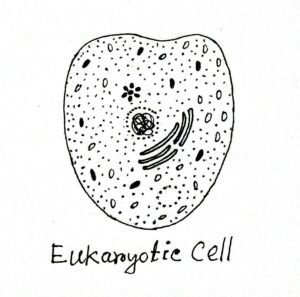The mesokaryotic cell is the intermediate cell of the Prokaryotic cell and the Eukaryotic cell. Dodge has first used the term mesokaryotic in 1966 for the cell that contains an intermediate nucleus (both eukaryotic and prokaryotic characters are present). Although Dougherty (1957) has divided cells into two types: prokaryotic cells and eukaryotic cells.
The name Mesokaryotic is derived from the Greek words Meso and Karyon.
“Meso = intermediate and karyon = nucleus“
Mesokaryotic cell contains a membrane-bound organized nucleus (a characteristic feature of eukaryotes) but performs nuclear division by amitotic method without disintegration of the nuclear membrane (like a prokaryotic cell). The nucleus of mesokaryotic cells resembles both prokaryotic and eukaryotic nuclei.
The cells are medium-sized and have membrane-bound cell organelles like – mitochondria, plastids, endoplasmic reticulum, etc. The organisms having mesokaryotic cells are called mesokaryotes.
Definition of Mesokaryotic Cell
The cells have an organized nucleus containing chromosomes with membrane-bound cell organelles (mitochondria, plastids, endoplasmic reticulum, etc.), and its nucleus is divided through the amitosis process without disintegration of the nuclear membrane are called mesokaryotic cells.

Characteristic Features of Mesokaryotic Cell
Mesokaryotic cells resemble both prokaryotes and eukaryotes. Their major characteristic features are as follows:
- The cells are medium-sized and the size of the cell is in between prokaryotic cells and eukaryotic cells.
- They do not have a cell wall but instead have a pellicle or theca.
- The cell membrane is present.
- The nucleus is well-organized and surrounded by the membrane.
- Membrane-bound cell organelles (like- mitochondria, plastids, endoplasmic reticulum) are present in the cytoplasm.
- The ribosomes in the cytoplasm are 80s type.
- The histone protein is completely absent in the cell.
- The chromosome is present and is formed with the help of acidic proteins.
- The centrosome is absent in the cytoplasm. So, the mitotic apparatus is not formed during cell division.
- Cell division occurs through the method of amitosis without disintegration of the nuclear membrane.
- Flagella are present and consist of filaments.
- The presence of chloroplast in the cell contains photosynthetic pigments.
- Respiratory enzymes are present in the cytoplasm or mitochondria.

Examples of Mesokaryotic Cell
Some examples of mesokaryotes are Peridinium, Gymnodinium of the algal group-Pyrrophyta, and Noctiluca of protozoa.
Structure of Mesokaryotic Cell
The different parts of a mesokaryotic cell visible on an electron microscope are as follows:
Theca or Pellicle
The mesokaryotic cell is surrounded by a thin layer of protein coat on the outside part of the plasma membrane or cell membrane called theca or pellicle.

The pellicle supports the plasma membrane. It is stiff in structure and maintains the cell’s shape which provides stability and flexibility to allow the movement of the mesokaryotic organism(mesokaryotes are mainly unicellular).
Plasma Membrane
In mesokaryotic cells, there is no cell wall. Below the pellicle layer, a lipo-proteinous plasma membrane is present.
Cytoplasm
The jelly-like quasifluid(semi-solid) that surrounds the plasma membrane is called the cytoplasm.
The cytoplasm contains a well-organized nucleus, ribosomes, mitochondria, endoplasmic reticulum, plastids, reserve food materials, lipids, glycogen granules, etc.
Nucleus
The nucleus is well organized and consists of the nuclear membrane, nucleoplasm, nuclear reticulum, and nucleolus. It is larger in size and has been named a mesokaryon by Dodge(1966).
In Dinokaryotes(e.g. Peridinium, Gymnodinium), a nucleus is a peculiar form called dinokaryon. In which the genetic materials(chromosomes) are surrounded by the nuclear membrane(eukaryotic character) but histone protein is not associated with DNA(prokaryotic character).
The nucleus controls all the biological activities of the cell and carries the genetic materials.
Chromosomes
Chromosomes are attached to the nuclear membrane and in the resting stage, they remain in coiled condition. In dinoflagellate, The chromosomes contain a novel, dominant family of nuclear proteins(Dinoflagellate viral nucleoproteins) that appear to be of viral origin.
Mitochondria
Rod-like double membraned cell organelles present in the cytoplasm are called mitochondria. Mitochondria help to produce energy in the cell.
Ribosomes
At present, little is known about mesokaryote ribosomes. It contains mainly ribosomal proteins. Ribosomes of mesokaryotic cells are 80S type.
Endoplasmic Reticulum
It is a tubular structure, found in the cytoplasm. The endoplasmic reticulum provides mechanical strength to the cell.
Chloroplast
Chloroplast is an oval or ribbon-like form, found in the cells of photosynthetic dinoflagellates. Each chloroplast is bounded by three membranes. It contains the photosynthetic pigments of chlorophyll-a and chlorophyll-c.
Reserve Food Materials
In dinoflagellate cytoplasm, starch and unsaturated fatty acids are present as reserve food materials.
Flagella
Dinoflagellates possess two dissimilar flagella arising from the surface of the pellicle on the ventral cell side. Flagella help in the process of locomotion.


Nice post